

School Chairs
Buying Guide
School Outfitters Tips
![]()
For students that require a custom school chair fit, measure from the bend of the knee to the floor and select the seat height that is closest to this measurement.
![]()
Choose smooth chair backs for easy cleaning or backs with handles for easier mobility.
![]()
Be sure to leave a 10 to 12-inch gap between the seat and the desk or tabletop.
![]()
When in doubt, order the larger size in the suggested range.
![]()
School chairs with nylon glides help protect floor surfaces and make moving the chair easy.
![]()
We recommend ordering the size chair that will fit at least 75% of your students.
School Chair Seat Height by Grade Level
5” - 8” Seat height | 9” - 11.5” Seat height | 12” - 13” Seat height | 13.5 - 14” Seat height | 15.5” - 16” Seat height | 17.5” - 18” Seat height | |
Preschool (Ages 1-2) | 75% | 25% | ||||
Preschool (Ages 3-5) | 75% | 25% | ||||
Kindergarten | 75% | 25% | ||||
Grade 1 | 25% | 75% | ||||
Grade 2 | 75% | |||||
Grade 3 | 25% | 75% | ||||
Grade 4 | 75% | 25% | ||||
Grade 5 | 75% | |||||
Grade 6 - Adult | 100% |
Preschool (Ages 1-2) | 5” - 8” Seat height | 9” - 11.5” Seat height |
75% | 25% | |
Preschool (Ages 3-5) | 9” - 11.5” Seat height | 12” - 13” Seat height |
75% | 25% | |
Kindergarten | 12” - 13” Seat height | 13.5 - 14” Seat height |
75% | 25% | |
Grade 1 | 12” - 13” Seat height | 13.5 - 14” Seat height |
25% | 75% | |
Grade 2 | 13.5 - 14” Seat height | |
75% | ||
Grade 3 | 13.5 - 14” Seat height | 15.5 - 16” Seat height |
25% | 75% | |
Grade 4 | 15.5 - 16” Seat height | 17.5 - 18” Seat height |
75% | 25% | |
Grade 5 | 17.5 - 18” Seat height | |
75% | ||
Grade 6 - Adult | 17.5 - 18” Seat height | |
100% |
School Chair Styles
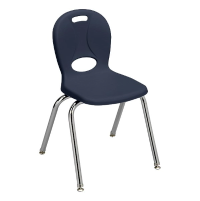
The most common chair found in a classroom is a Stacking School Chair. These chairs are made from polypropylene, a thermoplastic polymer known for its durability due to its impact resistance. Available in a full line of seat heights to accommodate any classroom age, there are also several design options to choose from based primarily on preference.
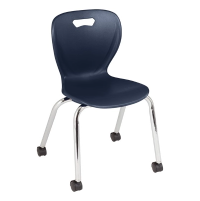
To spark creativity in the classroom, many teachers will prefer Mobile School Chairs. Students, just like adults, benefit from moving when sitting for long periods of time. Wheels on school chairs not only promote movement but allow for quick rearrangement throughout the day to encourage greater collaboration. Depending on the style, the wheels, or casters, can lock.
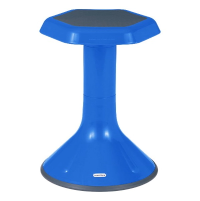
Another option to spark creativity are Wobble and Active Stools. Students have the flexibility of movement while sitting by rocking in any direction. Because it has a stool design, students can actively engage with those around them simply by pivoting while sitting.
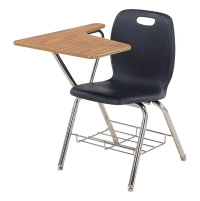
For convenience and classroom organization, school chairs can be purchased with a desk attached. The metal frame also includes a book box secured underneath the seat to hold books and personal belongings. The seat is usually available in several colors.
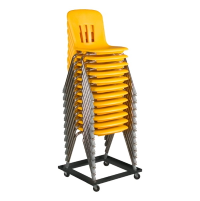
Chair dollies enable staff to easily stack and transport school chairs to ensure cleaning efforts are thorough. For convenience, several Stacking School Chair models have a chair dolly designed to fit. For others, a universal chair dolly can be used.
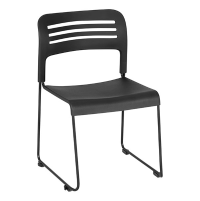
School chairs that move easily on carpet have sled bases. By design, sleds have two “legs” on either side that allow it to glide on the snow. This concept is applied to School Chairs with Sled Bases giving students more mobility on carpeted surfaces.
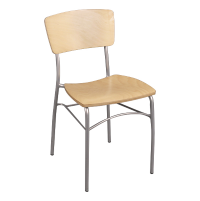
One of the more classic styles of school chairs are those made from solid wood. The most popular design is a ladderback where the seat back resembles ladder rungs. They are exceptionally sturdy and weigh a bit more than plastic chairs.
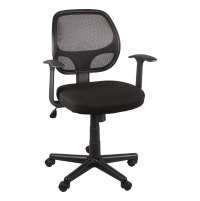
The chair a teacher uses throughout the day should accommodate the needs of a busy classroom with features that ensure durability and flexibility. Popular features include wheels for mobility, swivel seats, adjustable heights to fit any desk or table and cushioned seats for added comfort.
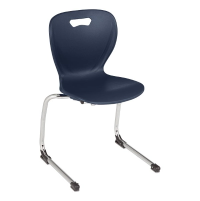
Chairs with a cantilever base do not have the traditional four legs. Rather, the base has an L-shape giving the user a moderate amount of movement, or rocking, while sitting. A Rocker Chair with a Cantilever Base has an attractive design and is intended to promote active learning.



